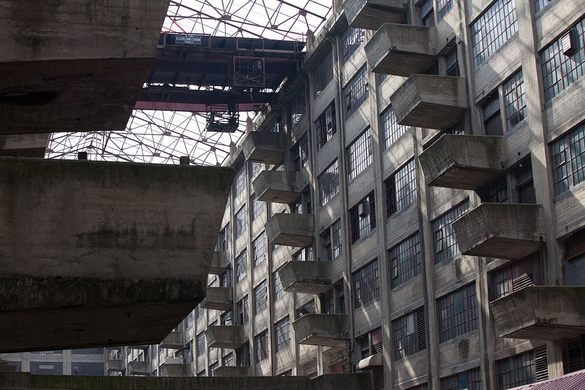Brooklyn Army Terminal Building B
Empty, but not abandoned, this cavernous Brooklyn loading dock was once considered the largest individual building in the world.
The architectural highlight of the enormous Brooklyn Army Terminal is the central atrium of Building B, a space that looks unlike anything you will find in a modern warehouse or factory.
Built as an intermodal rail and marine terminal to facilitate the movement of troops and supplies to Europe during World War I, the Brooklyn Army Terminal was designed by renowned architect Cass Gilbert, best know for creating ornate and grandiose structures like the Woolworth Building, the Supreme Court, and the New York Customs House. When it was completed in September 1919 – 10 months after the war had ended – it was, in fact, the largest concrete building in the world, said to contain as much building material as the Great Pyramid of Cheops, and longer than the Woolworth Building is tall.
The complex is made up of two nearly-identical main buildings, the primary difference between the two is Building B’s central atrium. Freight trains could drive directly into the building and unload their cargo onto the loading docks. Two 5-ton traveling electric cranes spanned overhead, each able to move the width and length of the space on a track. Each could lower a cable that would then be attached to items unloaded from the trains. The offset balconies were designed so that this overhead crane can deposit cargo in each level and each sector of the building. Once deposited into the warehouse, cargo could be moved through the buildings by means of a network of connecting skybridges, and eventually moved down onto three enormous waterfront piers and loaded onto ships.
During World War II, roughly 20,000 people worked at the complex, moving cargo as well as troops to fronts across the globe. Despite its enormous size, the Army Terminal was not the largest military supply base in the country, or even in New York City, but it did serve as the headquarters for the New York Port of Embarkation, a vast network of warehouses, piers, supply depots and camps scattered across the region that moved more troops and matieriel than any other port in the country.
The Terminal continued to operate in the post-war period, but by 1966, changing technologies, especially containerized cargo, had made this whole facility – and especially its atrium – obsolete. That year the Army Terminal was decommissioned, though it limped along with a few federal agencies continuing to occupy its cavernous spaces. In 1981, the complex was sold to New York City, and it is now a thriving industrial park, home to more than 100 businesses and employing more than 3,600 New Yorkers in a variety of industries.
Trains can no longer drive into the atrium – lobbies on either end of the building have severed the rail link – and the cranes aren’t functional. Despite the quiet, almost ghostly feeling of the atrium, Building B is fully occupied with tenants, and the atrium basically serves as a very, very large hallway for the building, but it still has many historical artifacts of note. The cranes are still in place with their old signage, and the balconies have been repurposed by tenants as sitting areas, gardens, and a place for their HVAC units. A somewhat anachronous Long Island Railroad bar car, moved into the space 30 years ago as decoration, sits on one of the tracks. And scattered throughout that atrium, you can still find markings noting destinations for military cargo – South America, Greece, India, and the Azores.
The Brooklyn Army Terminal is a secure industrial park, and it is not accessible to the public. However, the New York City Economic Development Corporation, which operates the site, in partnership with Turnstile Tours offers tours twice a month that explore the site, its history, and the contemporary uses, including visiting the atrium and unrestored areas of Building A. There are other opportunities to visit the site throughout the year, including Open House New York in October.
Know Before You Go
The Brooklyn Army Terminal is located in Brooklyn's Sunset Park, between 58th St and 65th St, and 2nd Ave and the water. The main entrance is located at the corner of 58th St and 1st Ave. It is a short walk from the 59th St N/R subway station.




















Follow us on Twitter to get the latest on the world's hidden wonders.
Like us on Facebook to get the latest on the world's hidden wonders.
Follow us on Twitter Like us on Facebook